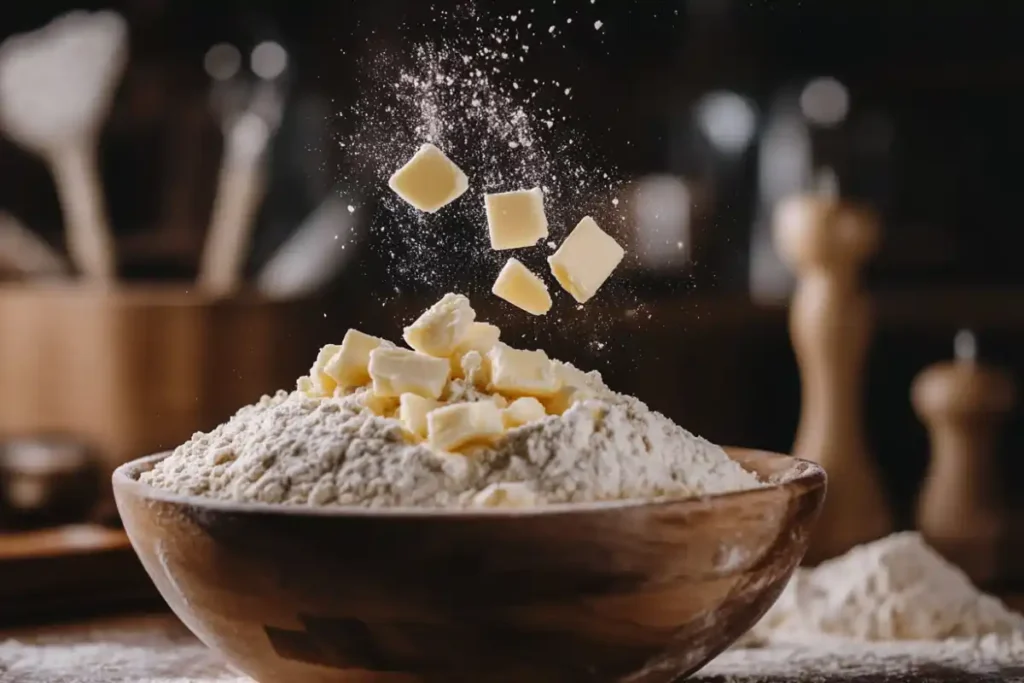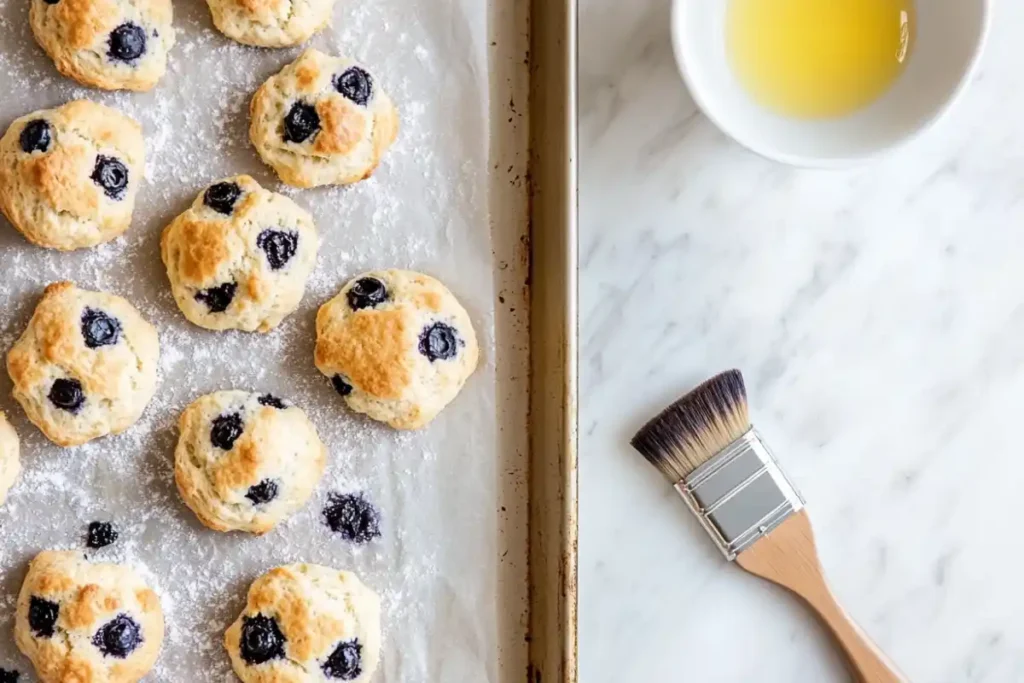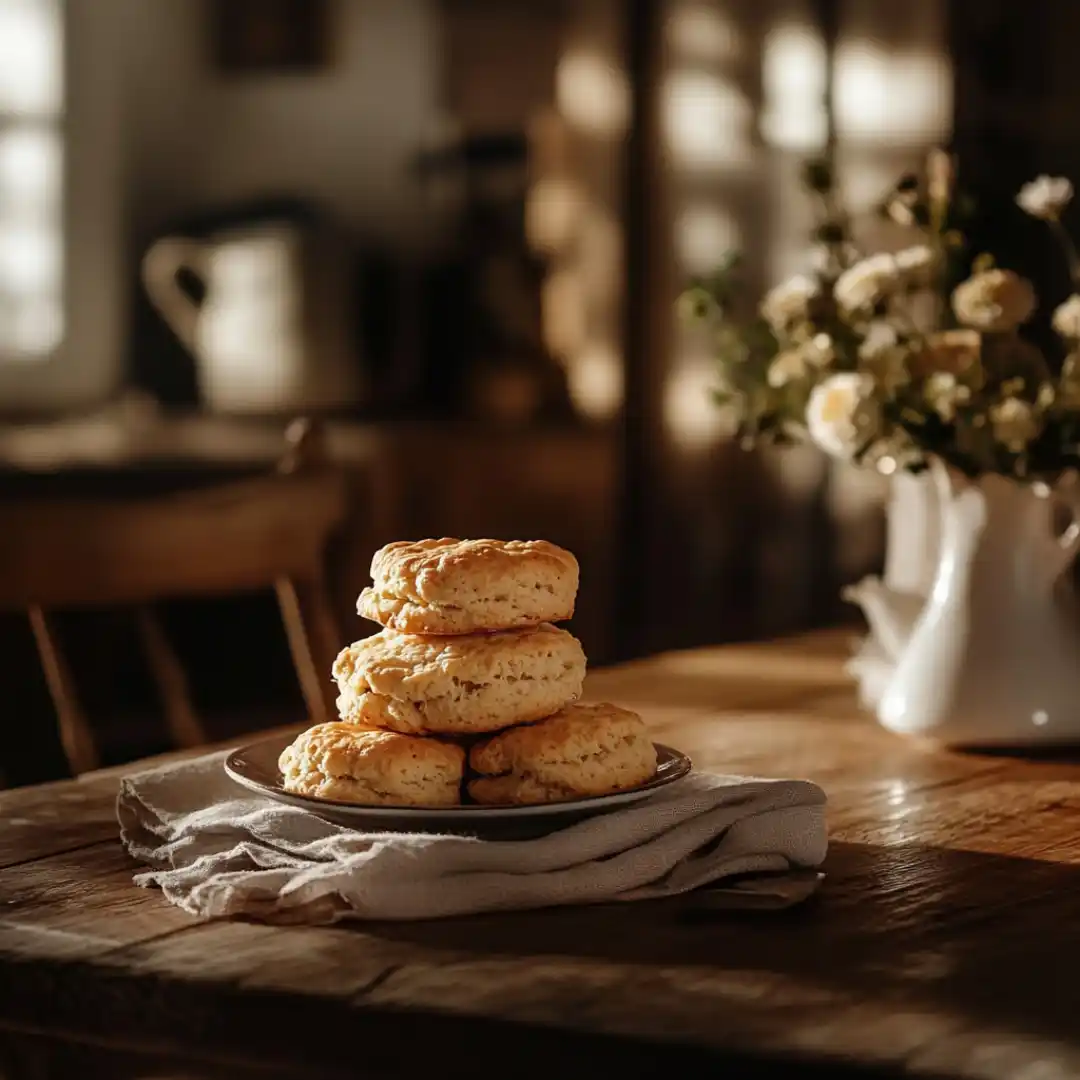Ever bitten into a scone that was more brick than biscuit? Yeah, we’ve all been there. But what is the secret to fluffy scones that are tender, light, and melt in your mouth? That’s the gold standard, and it’s not as elusive as it might seem. In this article, we’ll unravel the mystery behind what really makes scones fluffy and irresistible.
You’ll discover the crucial ingredients, science backed techniques, and baking secrets to help you avoid those dense disappointments. Whether you’re a seasoned baker or just trying to whip up something delightful for brunch, this guide will walk you through everything you need to know. We’ll even tackle some of Google’s most asked questions like “Why are my scones not fluffy?” and “Can I make fluffy scones without eggs?”
So, let’s kick off this scone journey with what’s happening under the hood, or should we say, under the crust—of a perfectly fluffy scone.
Understanding What Makes a Scone Fluffy
The Science Behind Fluffiness in Baked Goods
So, what is the secret to fluffy scones? It starts with a bit of kitchen science. When it comes to baked goods, fluffiness is all about the right combo of leavening agents, fat, and moisture. In scones, baking powder plays the leading role, creating gas bubbles that make the dough rise. But without a proper structure, all that air can escape, leaving you with a flat, sad snack.
Here’s the kicker: cold butter is essential. As it melts in the oven, it creates steam pockets, lifting the dough layer by layer. That’s how you get those airy, buttery layers we all love. And don’t forget the role of acidic ingredients like vinegar or buttermilk, they react with the leavening agent to boost that rise.
In essence, fluffiness isn’t magic, it’s chemistry. And when you understand how each ingredient works, baking fluffy scones becomes way less of a gamble.
Key Differences Between Scones and Biscuits
Let’s clear up the confusion, scones aren’t just British biscuits. While the two share some ingredients, the differences are in texture and richness. Biscuits (the American kind) are typically lighter and flakier, often served as a savory side. Scones, on the other hand, are richer and heartier, thanks to more butter and sometimes eggs.
Scones are also sweeter, and their crumb is a bit more tender. You’ll usually find them gracing a brunch table or afternoon tea, often bursting with berries, cream, or jam. Biscuits are more utilitarian, scones are a little fancier.
Still, both rely on the same foundational principle: cold fat + minimal handling = max fluff.
Ingredients That Influence Scone Texture
Why Cold Butter is Non Negotiable
Let’s not beat around the bush, cold butter is everything. If you’re still wondering what is the secret to fluffy scones?, start here. Cold butter is what creates those signature buttery layers and that dreamy soft interior. When cold butter melts in a hot oven, it releases steam. That steam? It’s what gives scones their lift and flaky texture.
Now, here’s the trick: instead of cubing your butter, try grating it straight from the fridge. This helps it spread more evenly through the dough without warming up too fast. Because let’s face it, melted butter before baking? That’s a one-way ticket to dense town.
Another secret? Don’t swap in margarine or spreadable alternatives. They simply don’t have the same fat structure. And without that, say goodbye to fluff.

Choosing the Right Flour and Leavening Agents
Not all flours are created equal. For the lightest, most airy scones, you’ll want a low-protein flour, like pastry flour or a good quality all purpose. High protein flour can toughen things up, definitely not what you want in a scone.
And don’t skimp on baking powder. It’s the leavening hero that gives your scones that lofty rise. Pair it with a bit of acidity, like buttermilk or vinegar, and you’ll double down on fluff.
One more thing: measure carefully. Too much flour, and your dough turns dry. Not enough, and you’ve got a gooey mess. Balance is everything.
👉 Pro tip: For a twist on flour types and alternative baking techniques, check out how to make gluten free banana bread moist and fluffy.
Expert Techniques to Achieve the Perfect Fluffy Scone
The Role of Dough Lamination
You’ve heard of laminating pastry for croissants, right? Guess what, it works magic for scones, too. Laminating simply means folding the dough over itself, again and again, to create layer upon layer. Each fold traps cold butter between sheets of dough, which puffs up into fluffy, pillowy layers when baked.
It might sound fancy, but it’s easy. Just roll out your dough, grate some butter on top, fold it over, and repeat. Three to four rounds usually do the trick. This technique adds structure and creates a melt in your mouth texture you won’t get from a simple stir and scoop method.
So if someone asks what is the secret to fluffy scones?, now you know, it’s in the folds.
Minimal Handling for Maximum Fluff
Don’t overthink this, less is more. Seriously. One of the most common baking mistakes? Overworking the dough. The more you knead, pat, and poke it, the more gluten you activate. And more gluten means tough, chewy scones. Not exactly what you’re going for, right?
Instead, mix just until your dough comes together. It should look a little shaggy, maybe even a touch messy. That’s good! That rustic look means you haven’t overmixed.
Also, try to keep your hands (and tools) cold. Warm hands can melt butter, ruining the fluff factor before you even hit the oven.
Need more inspiration on soft, tender textures in baked goods? This soft chocolate chip cookie guide is packed with techniques that also apply beautifully to scones.
Ingredient Substitutions and Their Effects
Can You Use Margarine Instead of Butter?
Here’s the deal, butter beats margarine every time when it comes to scones. One of the most common questions people ask is: What is the secret to fluffy scones? And truthfully, swapping butter for margarine isn’t it.
Butter has a high fat content and low water content. That’s what gives you those golden, buttery layers. Margarine, on the other hand, contains more water and often softens too quickly. This change can ruin the steam pocket magic that makes scones rise and fluff up in the oven. The result? Soggy, sad scones.
So if fluff is what you’re after, stick with unsalted, cold butter, always.
Fresh vs. Frozen Fruit in Scones
Let’s talk mix ins. Adding fruit is great, but fresh berries can turn your dough into a wet mess. Why? They release juice while you’re mixing and baking, which can weigh the dough down and block those all-important air pockets.
Frozen berries, especially blueberries, are the better choice. When baked, the frozen fruit slowly releases steam, helping to puff up the dough naturally. It’s like an added boost to your scone’s rise.
Curious about balancing moisture in baked treats? Take a peek at this banana bread recipe that stays moist and fluffy.
Baking Tips for Consistently Fluffy Results
Temperature Control and Oven Tips
You’ve prepped your dough, folded it with care, and now it’s go time. But wait, if your oven’s off, all your hard work could go up in smoke. That’s why oven temperature matters more than you think.
Preheat your oven fully, no shortcuts here. A hot oven (around 400°F / 200°C) gives the scones that immediate burst of heat they need to rise quickly. It’s this quick lift that creates the signature crusty top and soft inside.
Also, avoid opening the oven door too soon. Each peek drops the temperature and may stop your scones from reaching their full height.
Common Mistakes That Make Scones Dense
Even with the right ingredients and tools, a few missteps can flatten your scones. Here’s what to avoid:
- Overmixing: Stir just until the dough comes together. The less fuss, the better.
- Warm butter: We’ve said it before, but it’s worth repeating. Cold butter is key!
- Too much flour: Adding extra flour to stop sticking? That’s a fluff killer. Use parchment paper or chill the dough instead.
Also, give your dough room to grow. Crowding scones on a baking sheet can lead to uneven cooking and steam blocking.
👉 For more tips on getting your baked goods soft and tender, check out this guide to soft cookies. Many of the same rules apply!
Stay tuned, next, we’ll talk kitchen tools and prep hacks to make scone, making a breeze.
Equipment and Preparation Essentials
Tools That Make a Difference: Graters, Bench Scrapers, and More
Great scones don’t require a fancy kitchen, but the right tools do make things easier, and more foolproof. Want to know what is the secret to fluffy scones? Well, having the right gear is a solid start.
A box grater is your best friend when it comes to working with cold butter. Grating frozen or fridge cold butter directly into the flour helps it blend in evenly, keeping those tiny pockets of fat that turn into steam during baking.
Next up: a bench scraper. This humble tool helps fold the dough gently without adding too much heat from your hands. It’s also perfect for cutting clean, neat scone shapes without squishing the sides.
And don’t forget parchment paper. It keeps your baking tray mess-free and your scones from sticking, win win!
Preparing and Storing the Dough Properly
Dough prep is where many scone dreams go wrong. To keep your dough chill (literally), work quickly and in a cool space. If your kitchen runs warm, pop the dough in the fridge for a few minutes between steps.
Once shaped, scones can rest in the fridge before baking. This helps firm up the butter again, ensuring the fluffiest rise in the oven.
Want to store unbaked scones for later? Freeze them on a tray, then transfer to a zip-top bag. You can bake them straight from frozen, just add a few extra minutes.

Recipe Walkthrough: Fluffy Blueberry Scones
Step by Step Instructions with Tips
Let’s put all this theory into action. Here’s a simple walkthrough for fluffy blueberry scones, perfect for brunch, tea, or just because.
Ingredients:
- 4 cups all purpose flour
- 2 tbsp baking powder
- ½ tsp salt
- 1 cup unsalted butter (cold, grated)
- 2 eggs
- 1 cup milk
- 2 cups frozen blueberries
- 1 egg + 1 tbsp water (egg wash)
Steps:
- Preheat your oven to 400°F (200°C).
- In a large bowl, mix flour, baking powder, and salt.
- Grate cold butter into the bowl and mix lightly.
- Whisk eggs and milk, then add to the dry mix. Gently combine until just shaggy.
- Turn the dough onto a floured surface. Press into a rectangle, sprinkle some grated butter, and fold.
- Repeat folding and buttering 2–3 more times (that’s your lamination magic).
- Fold in frozen blueberries last, avoid overmixing!
- Cut into rounds or wedges using a bench scraper.
- Place on a lined baking sheet, brush with egg wash, and sprinkle with sugar if you like.
- Bake for 20–25 minutes until golden and puffed.
Enhancing Flavor Without Sacrificing Texture
Want to level things up? Add lemon zest, a splash of vanilla, or a pinch of cinnamon. These boost flavor but won’t mess with the texture.
And remember, if you’re still asking what is the secret to fluffy scones?, it’s a mix of cold ingredients, gentle hands, and a hot oven. Stick with that formula, and you’ll have bakery-level scones every time.
FAQs People Also Ask
Why are my scones not fluffy?
This one comes up a lot, and for good reason. If your scones come out flat or dense, several culprits might be to blame. One common issue is overmixing the dough, which develops too much gluten. That makes your scones tough instead of tender.
Another reason? Warm butter. If your butter melts before baking, you lose the steam effect that creates rise. Cold ingredients are key! And don’t forget proper oven temperature. Starting with a fully preheated oven gives the dough that quick lift.
Still wondering what is the secret to fluffy scones? It’s a careful dance between cold fats, gentle handling, and high heat. Stick to that trio, and your scones will puff up beautifully.
Should you knead scone dough?
Nope! You should barely touch scone dough. Kneading activates gluten, and that’s the opposite of what you want. A light mix, just enough to bring everything together, is all it takes.
What makes a scone moist?
Fat and just the right amount of liquid. Butter, eggs, and milk all add richness and moisture. But too much liquid can make scones spread or turn gummy. The goal is balance.
Can you make fluffy scones without eggs?
Yes, you can! While eggs add richness and help bind the dough, they aren’t a must. Try using a bit of extra milk or a spoonful of yogurt as a substitute. Your texture may vary slightly, but with cold butter and a good rise, they can still be fluffy.
Conclusion: The Real Secret to Fluffy Scones
So, what is the secret to fluffy scones? It turns out, it’s not just one thing, it’s a combo of smart choices, careful technique, and a touch of baking intuition. From using cold butter and light hands to mastering the lamination fold and keeping your oven hot and steady, every step matters.
But here’s the good news: once you understand the “why” behind the process, baking fluffy scones isn’t just possible, it’s actually pretty fun. You don’t need a fancy kitchen or years of experience. Just stick to the basics: keep your ingredients cold, don’t overwork the dough, and bake with confidence.
Whether you’re whipping up a batch for a cozy weekend brunch or sharing them over afternoon tea, nothing beats the first bite of a perfectly fluffy scone. And now that you’ve got the secrets, you’re ready to make it happen.
Go on, get your hands a little floury and give it a try. Your future self (and anyone lucky enough to eat your scones) will thank you.
